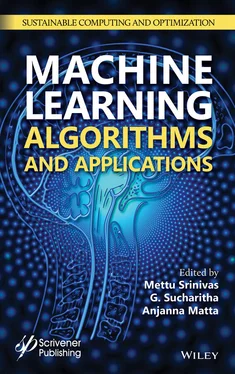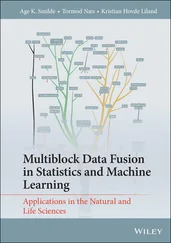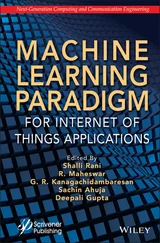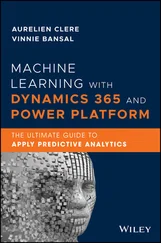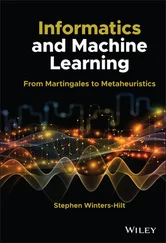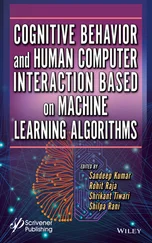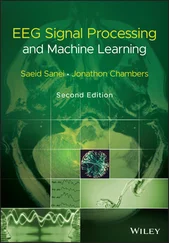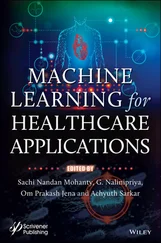Machine Learning Algorithms and Applications
Здесь есть возможность читать онлайн «Machine Learning Algorithms and Applications» — ознакомительный отрывок электронной книги совершенно бесплатно, а после прочтения отрывка купить полную версию. В некоторых случаях можно слушать аудио, скачать через торрент в формате fb2 и присутствует краткое содержание. Жанр: unrecognised, на английском языке. Описание произведения, (предисловие) а так же отзывы посетителей доступны на портале библиотеки ЛибКат.
- Название:Machine Learning Algorithms and Applications
- Автор:
- Жанр:
- Год:неизвестен
- ISBN:нет данных
- Рейтинг книги:4 / 5. Голосов: 1
-
Избранное:Добавить в избранное
- Отзывы:
-
Ваша оценка:
- 80
- 1
- 2
- 3
- 4
- 5
Machine Learning Algorithms and Applications: краткое содержание, описание и аннотация
Предлагаем к чтению аннотацию, описание, краткое содержание или предисловие (зависит от того, что написал сам автор книги «Machine Learning Algorithms and Applications»). Если вы не нашли необходимую информацию о книге — напишите в комментариях, мы постараемся отыскать её.
Machine Learning Algorithms and Applications — читать онлайн ознакомительный отрывок
Ниже представлен текст книги, разбитый по страницам. Система сохранения места последней прочитанной страницы, позволяет с удобством читать онлайн бесплатно книгу «Machine Learning Algorithms and Applications», без необходимости каждый раз заново искать на чём Вы остановились. Поставьте закладку, и сможете в любой момент перейти на страницу, на которой закончили чтение.
Интервал:
Закладка:
Preface
Nowadays, machine learning has become an essential part of many commercial and industrial applications and research developments. It has expanded its roots in areas ranging from automatic medical diagnosis in healthcare to product recommendations in social networks. Many people think that machine learning can only be applied by large companies with extensive research teams. In this book, we try to show you how you yourself can easily adopt machine learning to build solutions for small applications and the best way to go about it. With the knowledge presented herein, you can build your own system to find the faults in a company’s manufactured products and the fake profiles in social networks. This book clearly explains the various applications of machine and deep learning for use in the medical field, animal classification, gene selection from microarray gene expression data, sentiment analysis, fake profile detection in social media, farming sectors, etc.
For the ambitious machine learning specialists of today who are looking to implement solutions to real-world machine learning problems, this book thoroughly discusses the various applications of machine and deep learning techniques. Each chapter deals with the novel approach of machine learning architecture for a specific application and its results, including comparisons with previous algorithms. In order to present a unified treatment of machine learning problems and solutions, many methods based in different fields are discussed, including statistics, pattern recognition, neural networks, artificial intelligence, sentiment analysis, control, and data mining. Furthermore, all learning algorithms are explained in a way that makes it easy for students to move from the equations in the book to a computer program.
The Editors
June 2020
1
A Learning-Based Visualization Application for Air Quality Evaluation During COVID-19 Pandemic in Open Data Centric Services
Priyank Jain* and Gagandeep Kaur†
Dept. of CSE & IT, Jaypee Institute of Information Technology, Noida, Uttar Pradesh, India
Abstract
Air pollution has become a major concern in many developing countries. There are various factors that affect the quality of air. Some of them are Nitrogen Dioxide (NO 2), Ozone (O 3), Particulate Matter 10 (PM 10), Particulate Matter 2.5 (PM 2.5), Sulfur Dioxide (SO 2), and Carbon Monoxide (CO). The Government of India under the Open Data Initiative provides data related to air pollution. Interpretation of this data requires analysis, visualization, and prediction. This study proposes machine learning and visualization techniques for air pollution. Both supervised and unsupervised learning techniques have been used for prediction and analysis of air quality at major places in India. The data used in this research contains the presence of six major air pollutants in a given area. The work has been extended to study the impact of lockdown on air pollution in Indian cities as well.
Keywords:Open Data, JSON API, OpenAQ, clustering, SVM, LSTM, prediction, Heat Map visualizations
1.1 Introduction
1.1.1 Open Government Data Initiative
These days, Open Government Data (OGD) is gaining momentum in providing sharing of knowledge by making public data and information of governmental bodies freely available to private citizens in system processable formats so as to reuse it for mutual benefits. OGD is a global movement and has its roots in the initiative started in 2009 by the US President as a Memorandum on Transparency and Open Government providing transparency in government projects and collaborations through sharing of data by public administration and industry to private citizens. Indian Government also has joined this initiative and provides free access to the data for development of applications, etc., so as to be able to reuse the information for mutual growth of industry and government. Open Data is the raw data made available by governments, industry, as well as NGOs, scientific institutions, and educational organizations and as such is not an individual’s property.
The growth in the field of Open Data surely asks for new tools and techniques that can support it. Digital transformation needs companies to look out for new tools and techniques so as to be able to support the increasing need for faster delivery of services at large numbers of delivery points. Technologies like SaaS, mobile, and Internet of Things are gaining grounds in providing increase in endpoints and thus enabling the success of Open Data Initiative.
1.1.2 Air Quality
A report, State of Global Air 2017, by Institute for Health Metrics published recently [1] stated that, in the year 2015, there have been 1,090,400 deaths in India only due to an increase in PM 2.5. High concentration of PM 2.5in the air is majorly caused by burning of petroleum fuels, household fuels, wooden fuels, agricultural fires, and industry related pollutants and contaminants. In 2015, India and Bangladesh came next to North African and Middle East countries in terms of places with high concentration of PM 2.5in air.
The report compares the ambient concentrations to the air quality guidelines established by the WHO in 2005. Based on the report by WHO, in the year 2015, 92% of the world’s population and 86% of Indian population lived in unsafe areas exceeding safe limits. It is therefore need of the hour to develop tools that can provide better forecasting and easy understanding of the surrounding environment to naive users with lowest cost possible. Air Quality Index (AQI) is a commonly used index by agencies to provide information about quality of air in the vicinity to its residents.
The irony of today’s Internet world is that even when we are inundated with large quantities of data or information, we as humans still struggle with its rightful interpretation. Extracting meaningful information from plain textual data in old tabular formats is an extraneous task. It is under these circumstances that data visualizations play a vital role.
The objective of this work was to build a machine learning–based visualization app for air quality evaluation and air pollution assessment by assessing various parameters by which air is getting polluted. Existing approaches did not account for variations in values of parameters at different locations. That is why we have trained different models for different locations to capture the trends better.
1.1.3 Impact of Lockdown on Air Quality
COVID-19 is a highly infectious disease caused by a newly discovered Coronavirus which was firstly identified in Wuhan, Central China. It has taken more than 460,000 lives as on 20th June, 2020, around the world. Due to this pandemic, a nationwide lockdown was imposed in India from 24th March, 2020, which extended up to several weeks. It is observed that lockdown could help in reducing pollution levels to a certain extent. This study tries to capture the variations in air pollution levels with and without lockdown.
1.2 Literature Survey
Air pollution occurs when particulates (pm 2.5and pm 10), biological molecules, and other harmful substances are introduced into Earth’s atmosphere. Natural processes and human activities can both generate air pollution. Air pollution can be further classified into two sections: visible air pollution and invisible air pollution.
Proactive monitoring and control of our natural and built environments is important in various application scenarios. Semantic Sensor Web technologies have been well researched and used for environmental monitoring applications to expose sensor data for analysis in order to provide responsive actions in situations of interest [2]. A sliding window approach that employs the Multilayer Perceptron model to predict short-term PM 2.5 pollution situations is integrated into the proactive monitoring and control framework [2]. Time series data in practical applications always contain missing values due to sensor malfunction, network failure, outliers, etc. [3]. A spatiotemporal prediction framework based on missing value processing algorithms and deep recurrent neural network (DRNN) has been proposed [3]. A generic methodology for weather forecasting is proposed by the help of incremental K-means clustering algorithm in [4]. Air pollution data are available to the public as numeric values on the concentration of pollutants in the air on a web page [5, 6]. The numeric information is not conducive to determining the air pollution level intuitively [6]. To address this problem, the study developed and implemented a program for visualizing the air pollution level for six pollutants by obtaining real-time air pollution data using API and generating a keyhole markup language (KML) file defined to visualize the data on Google Earth intuitively [6]. Visualization method is intuitive and reliable through data quality checking and information sharing with multi-perspective air pollution graphs [7]. This method allows the data to be easily understood by the public and inspire or aid further studies in other fields [7]. As the tools are invented using spatial-temporal visualization and visual analytics for general visualization purposes of geo-referenced time series data of air quality and environmental data, they can be applied to other environmental monitoring data (temperature, precipitation, etc.) through some configurations [8].
Читать дальшеИнтервал:
Закладка:
Похожие книги на «Machine Learning Algorithms and Applications»
Представляем Вашему вниманию похожие книги на «Machine Learning Algorithms and Applications» списком для выбора. Мы отобрали схожую по названию и смыслу литературу в надежде предоставить читателям больше вариантов отыскать новые, интересные, ещё непрочитанные произведения.
Обсуждение, отзывы о книге «Machine Learning Algorithms and Applications» и просто собственные мнения читателей. Оставьте ваши комментарии, напишите, что Вы думаете о произведении, его смысле или главных героях. Укажите что конкретно понравилось, а что нет, и почему Вы так считаете.
